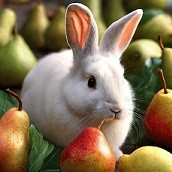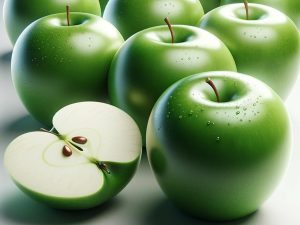Can Rabbits Eat Green Apples? How Much Can They Eat? Nutritional Insights for Fruits
Key Takeaways:
- Rabbits can enjoy green
as a treat, but moderation is key. - Only the flesh of the
is safe for rabbits – seeds and stem should be removed. - Be aware of the sugar content in apples and limit the portion size accordingly.
- Introduce green apples slowly into your rabbit’s diet to monitor for allergies.
- Always choose organic apples to avoid exposing your rabbit to harmful pesticides.
Crunching Into the Basics: Can Rabbits Safely Consume Green Apples?

“Free Stock Photo of Green apples food fruit healthy raindrope snack water apple granny smith eating apple fruit edible fruit produce pome food grape healthy sweet diet fresh health juicy apples vitamin” from freerangestock.com and used with no modifications.
Let’s cut to the chase: yes, rabbits can eat green apples, but there’s a bit more to it than just serving up a slice. Green apples should be treated as a sweet indulgence for your furry friend, not a daily diet staple. Because rabbits have sensitive digestive systems, it’s crucial to understand how to properly incorporate these
Identifying the Safe Parts of a Green Apple for Rabbits
When it comes to feeding your rabbit green apples, think of it like preparing a meal for a picky eater. The flesh of the apple is perfectly fine for rabbits, but the seeds and stem are a big no-no. Why? Apple seeds contain amygdalin, which can release cyanide when metabolized. So, make sure to core the apple and remove all seeds before offering a piece to your bunny.
Recognizing Signs of Allergic Reactions in Rabbits
Just like humans, rabbits can have allergies too. When you first introduce green apples to your rabbit, keep an eye out for any unusual symptoms. If you notice soft stool, less energy, or a lack of appetite, it could be a sign that your rabbit isn’t taking well to the new treat. Always start with a tiny piece to test the waters.
Example: When I first gave Benny, my lop-eared bunny, a piece of green apple, I watched him like a hawk. Thankfully, he had no adverse reactions, and it’s now his favorite Sunday treat.
Portion Size Decoded: How Much Green Apple is Healthy for a Rabbit?

“Free Stock Photo of composite manipulation photo manipulation apple fruit granny smith food eating apple tomato diet healthy produce fresh vegetable eat sweet nutrition juicy health ball pome edible fruit apples |” from freerangestock.com and used with no modifications.
Portion control is vital. Rabbits should only have fruit in small amounts—a few small pieces of green apple once or twice a week is plenty. This ensures that they still have room for their main diet of
- Adult rabbit: 1-2 tablespoons of chopped green apple.
- Baby rabbit: Avoid fruits altogether; their stomachs are too sensitive.
Remember, the key is to treat fruits like a special bonus, not a regular part of their meal plan.
Understanding the Impact of Sugar on Rabbit’s Health
Green apples, while healthier than their red counterparts, still contain sugar. And for rabbits, too much sugar can lead to obesity and digestive issues. This is why it’s crucial to stick to the recommended portion sizes.
Did you know? A rabbit’s digestive system is designed for processing high-fiber, low-sugar foods. Straying from this can lead to health problems.
Balancing Rabbit Diets with Fruit Treats
So, how do you strike the perfect balance? It’s simple: prioritize hay, fresh greens, and fiber-rich pellets. These should make up the bulk of your rabbit’s diet. Then, sprinkle in the occasional fruit treat like green apples to keep things interesting for your bunny.
- Hay: 80-90% of the diet.
- Vegetables: A handful of different types each day.
- Pellets: 1/8 to 1/4 cup per 5 pounds of body weight.
- Fruit: A small portion as a treat, not daily.
By following these guidelines, you’ll ensure your rabbit has a balanced diet while still enjoying the occasional sweet treat.
Vital Nutrients and Potential Toxins in Green Apples
Green apples aren’t just a tasty treat; they also pack a punch of essential nutrients. They contain vitamins like Vitamin C and dietary fiber, which can contribute to your rabbit’s overall health. However, we must be cautious. Besides the seeds and stem, you also need to consider the apple’s skin, which may harbor pesticide residues if not properly washed or, better yet, peeled.
The Nutritional Benefits of Green Apples to Rabbits
Here’s the good news: green apples offer antioxidants and phytochemicals that can support a healthy immune system in rabbits. Plus, the fiber in apples can help maintain a healthy digestive tract. But remember, these benefits come with the caveat of moderation due to the sugar content.
Detox Alert: Harmful Substances in Green Apples
Most importantly, we need to be vigilant about the potential toxins. Pesticides used on apple crops can be harmful to your rabbit. Therefore, opting for organic green apples is the best way to minimize these risks. And always wash or peel the apple skin to reduce exposure to any remaining chemicals.
- Choose organic to avoid pesticides.
- Wash or peel the apple skin before serving.
- Remove all seeds and the stem to prevent the risk of cyanide poisoning.
Introducing Fruits to Your Rabbit’s Diet
Introducing new foods to your rabbit should be a slow and steady process. Start with a tiny piece of green apple and observe your rabbit over 24 hours for any signs of discomfort or digestive upset.
When I introduced green apples to my rabbit, Thumper, I gave him a small piece and monitored his behavior and stool. After seeing no negative reactions for a few days, I gradually made it a part of his weekly treat routine.
Steps to Safely Introduce Green Apples
Here’s a quick guide to safely introduce green apples to your rabbit:
- Begin with a small piece of apple, without seeds or stem.
- Monitor your rabbit for 24 hours for any signs of digestive issues.
- If there are no adverse reactions, gradually increase the portion over several weeks.
Monitoring Your Rabbit’s Digestive Response
Keep an eye on your rabbit’s stool and behavior after introducing green apples. If you notice any changes, it’s best to remove the fruit from their diet and consult with a vet.
Negating The Risks: Ensuring Safe Fruit Consumption
Besides that, to negate the risks associated with fruit consumption, always ensure you’re feeding the right parts of the fruit and that you’ve properly prepared it. This means no seeds, no stem, and a good wash or peel to remove any pesticides.
Avoiding Pesticides: Selecting Organic Apples for Your Rabbit
Choosing organic apples is a straightforward way to avoid exposing your rabbit to harmful pesticides. If organic isn’t available, thoroughly washing the apple or peeling it is the next best thing.
Other Safe Fruit Alternatives for Rabbits
If you’re looking for variety, there are other safe fruit options for your rabbit. Remember, these should also be given in moderation:
- Bananas (without the peel)
- Blueberries
- Strawberries (tops are okay too!)
By mixing up the treats, you can provide a range of nutrients and keep mealtime exciting for your bunny.








Leave a Reply